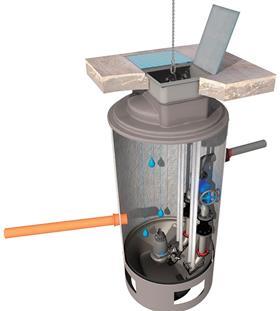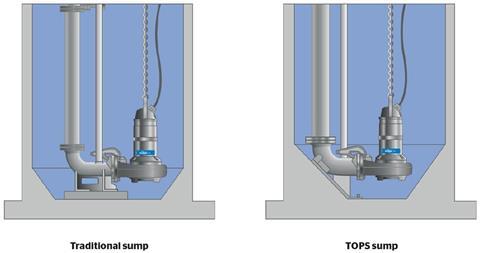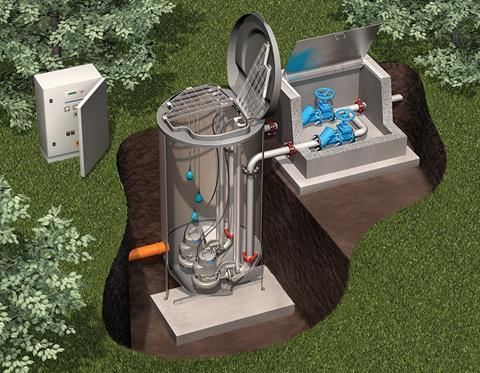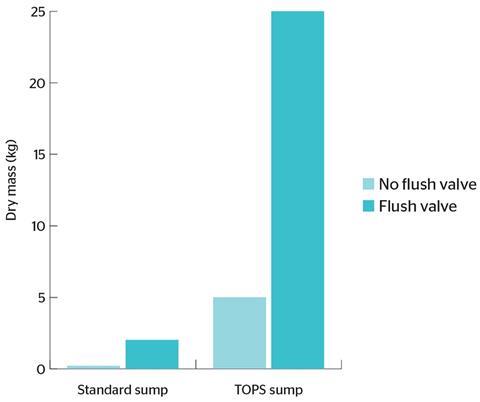The latest in our series of CPD modules focuses on best practice in the design of pumping stations as part of an effective modern sewerage network. This module is sponsored by Xylem Water Solutions UK
How to take this module
The free continuing professional development distance learning programme from Building is open to anyone who wants to develop and improve their professional knowledge. These modules can contribute towards annual CPD activity and help you to maintain membership of professional institutions and bodies.
To take this module, read the technical article above and click through to the multiple-choice questionnaire.
![]()
Once taken you will receive your results and if you successfully pass you will be automatically issued with a certificate to print for your records. This module will contribute one hour towards your CPD obligations.
DEADLINE: 6 JUNE 2014.
Introduction
Sewerage networks collect wastewater from residential, industrial, and service establishments and carry it to treatment plants. They must be designed so that solids are transported without interruption all the way through the system. Although advances have been made in the design of sewers, the pumping stations that are required
to pass solids through the system remain a common problem area. These can easily become clogged, which can render even the most efficient system ineffective.
The root of this problem is often the pump sump - the area in which the pumps are housed. The role of the sump is to provide an optimal operating environment for the pumps, to equalise the irregularity of the inflow, and to facilitate the transportation of sewage solids. However, they can often become stagnant areas blocked with excessive build-up of sludge and debris.
In recent years, this has become an area of increasing concern. Pumping wastewater is an energy-intensive process, which means it is an issue both for governments - which want to be seen to take energy conservation seriously - and for privatised utilities focused on reducing their costs. Demands have therefore risen for non-clogging pumps that can reliably pump unscreened raw sewage while retaining high efficiency.
This CPD will provide an introduction to the requirements of handling wastewater, and the key role that sump design plays in maximising the efficiency of a pumping system.

Sediment movement
Characteristics of solids
The typical solids found in raw sewage are faecal and organic matter in the form of gross solids or sludge, and litter such as paper, rags and sanitary waste. Storm water adds silt, sand, gravel and material from construction work, as well as litter such as paper, plastic and cans. In industrialised countries, the load of solids in sewage is typically 100-500mg/l for sanitary solids and 50-1,000mg/l for storm water solids.
Although these concentrations of solids may appear to be low, the gross quantity of solids passing through the system may be significant. Particularly when a disturbance in the flow of solids occurs, the concentration tends to rise rapidly. The solids should, therefore, never be ignored in the design of a sewerage system, or its individual components.
A useful, albeit simplified, classification of solids, is based on their specific gravity (SG) and hence their buoyancy:
- Settling solids, SG>1. Includes most inorganic materials such as grit, sand, silt and some heavy organic matter
- Neutral-buoyancy solids, SG=1. Includes most organic matter and sanitary and other refuse such as paper, plastic and rags
- Floating solids, SG<1. Includes fats, plastics, hollow objects and light organic matter.
Sediment movement in a sewer
The flow rate in any sewer varies greatly, as does the sediment transport rate. These variations are usually the greatest in sewers in which sewage and storm water are combined, but daily and seasonal variations are also significant. In small sewers, with intermittent flows, most solids settle between flush waves. Sediment travels down the sewer in several ways: fine, light material tends to travel in suspension, while heavier material rolls, slides and tumbles as bed load.
Three main groups of parameters affect the mode of transportation. These are the material properties of the solids (density, particle size and shape, size distribution and cohesive properties), the properties of the conduit (size, shape, slope and surface roughness) and the flow conditions (velocity, level of turbulence and depth). The same material may be transported in different modes depending on the combination of these parameters.
The heaviest solids, such as sand and gravel, are the main concern in the design of sewers, because they require the highest shear forces and the highest velocities to be carried by the water. Other lighter materials, such as rags and sanitary waste, move more readily. They, like the granular solids, may move in suspension or roll on the bottom. Rags, in particular, tend to agglomerate and become entangled when they roll on the bottom for a long distance. They can form “ropes” or “balls” that may become a major hazard to the pumps further down the line. Because these ropes and balls cause no problem in the sewers themselves, they tend to be ignored in analysis of the movement of solids.
Numerous guides are available for the design of self-cleansing sewers. They are based on either a minimum allowable velocity under certain flow conditions or a minimum shear stress. The minimum flow velocity is the most widely used criterion. For example, two key velocities are used in the UK: a flow of at least 0.75m/s once daily or 1.0m/s at a full-bore flow capacity. These criteria are used in most cases, but their weakness is that the values are arbitrary - no account is taken of the quantity or type of sediment, nor of the pipe size.
The criterion of a minimum required shear stress is more directly related to forces governing the sediment movement. However, since sewage solids are non-uniform, the choice of the minimum shear stress is also to some extent arbitrary. Useful limiting values of shear stress appear to be 1-2Pa for foul sewers and 3-4Pa for surface water sewers.

Sediment movement in a sump
Sediment movement in a pump sump differs from that in a sewer. The flow in a sump is less regular, in both direction and capacity. With intermittent pump operation (the main type), a pump sump acts periodically as a settling tank. The SG>1 solids settle on the bottom and accumulate in the still areas. They can only enter the pump if they are within the influence of the pump suction where the velocity exceeds the threshold of movement. If allowed to remain undisturbed, they may turn septic and cause odour problems, as well as increase corrosion and release hazardous gases. The sumps will also require periodic desludging, increasing operation costs.
Neutral buoyancy solids are carried by the flow and, in general, are easily pumped away. Long, stringy materials, however, can cause pumping problems either by hanging on the impeller blades or by blocking the pump inlet. Most severe clogging is caused by the ropes that can be created either in long sewers or in the sump - if caught by a rotating impeller, the longest objects catch other materials and become entangled with them. Since they seldom pass through the pump, these ropes tend to grow, becoming far longer than the individual pieces. They hang at a pump inlet when the pump operates, obstructing pump performance, and fall back to the sump bottom when the pump has stopped. At some point, they may completely block the pump.
The floating solids (SG<1) present a particular problem, since they float to the surface of the sump and rise and fall with the changing water level without being drawn into the pump. The combination of fats and floating rags tends to form thick rafts, which obstruct level sensors and may block pumps if they break into smaller pieces. The floating solids must also be within the influence of the pump suction to enter the pump. As discussed below, this can be achieved by lowering the water surface below commonly accepted minimum levels.
Design considerations for pump sumps
Most pumping stations in a sewerage system are fairly small, often circular in design and equipped with two pumps. Traditionally, sumps have been designed to provide ample space for pumps and to facilitate access for service personnel. However, the larger the sump, the more likely it is that it will become a settling tank for sludge and debris. Sumps do need to be large enough to avoid obstructing pump operation, but tests by sump manufacturer Flygt have shown that neither the proximity of the walls themselves nor the clearances between pumps have any effect on pump performance.
Flygt has developed a set of design criteria for a self-cleansing sump by conducting laboratory tests of sediment movement. These criteria can be summarised as follows:
- The flat bottom area of a sump must be kept to a minimum and located directly under the pump suction
- All other surfaces must be vertical or steeply inclined - at least 45 degrees for smooth surfaces (plastics or coated concrete) or at least 60 degrees for concrete
- The distance from the pump suction inlet should be less than half the diameter of the inlet
- The pumps must occasionally operate to the lowest possible liquid level in the sump - that is, to the point of incipient air ingestion or “snore”
- The inflow should be prevented from cascading directly onto the pumps or in the vicinity of the pump inlet.

Sump configuration
Sump diameter and bottom configuration are the characteristics that most affect the transport of solids. Because the suction effect of the pump inlet decreases rapidly with distance, it is important that the solids be guided towards the inlet. The position of the inflow to the sump is critical, and the free spaces have to be designed to form passageways to facilitate the movement of solids.
Nevertheless, during the idle phase of a pumping cycle, heavy solids will settle to the bottom. To pump them away, the shear force over the bottom, which is induced by the suction of the pump, has to exceed a certain critical value, which is dependent on the sediment type. The closer the pump inlet is to the bottom, the greater the shear force scouring the sediment.
Liquid level
The floating solids, as with the settling ones, can only enter the pump if they are within the influence of the pump suction. Lowering the liquid level in relation to the position of the pump inlet is, therefore, an important factor. Occasionally running pumps to the minimum water level - or the beginning of snore - helps to maintain a sump free from floating solids. Here again, the comparatively large surface area in a standard sump is a disadvantage, as the floating solids can still be some distance from the pump inlet.
Neutral-buoyancy solids move readily with the flow currents in the sump. They tend to accumulate in the stagnant zones, and can become easily trapped by fixed objects, such as pipes and cables. Once more, the smaller the volume of the sump, the more effective the movement of the solids. As with settling and floating solids, tests have shown that most of the neutral-buoyancy solids enter the pump when the water level in the sump is at its lowest, just before the pump switches off.
A controller module can be used to programme the pumps to run down to the minimum level in the sump. Depending on the influx of solids, and thus the need for sump cleansing, this controller can force the pumps to operate to the point of snore as many times as required.
Flush valves
A flush valve stirs up water in the sump at the start of each pump cycle, resuspending solids and making them easier to pump away. Tests have shown that such valves can enhance the transportation of solids significantly.
The graph below shows the mass of settling solids pumped out of the standard and TOPS sumps in one pumping cycle, with and without flush valves.

Conclusion
The need to transport wastewater, including all solids, through a sewerage system to treatment plants can only be met if pumping stations are as effective in handling sewage solids as the sewers themselves. Pumps that can handle solids without becoming clogged are obviously required. Pump sumps must also be constructed in such a way as to enhance the transport of solids. The following points are particularly important:
- Sumps can be designed with much smaller floor areas and with smaller clearances to the sump bottom and walls than conventional designs. This will reduce sedimentation and facilitate the ingestion of solids by a pump.
- Running pumps to the minimum water level from time to time will help to keep the sump free from floating solids.
How to take this module
The free continuing professional development distance learning programme from Building is open to anyone who wants to develop and improve their professional knowledge. These modules can contribute towards annual CPD activity and help you to maintain membership of professional institutions and bodies.
To take this module, read the technical article above and click through to the multiple-choice questionnaire.
![]()
Once taken you will receive your results and if you successfully pass you will be automatically issued with a certificate to print for your records. This module will contribute one hour towards your CPD obligations.
DEADLINE: 6 JUNE 2014.
Privacy policy
Information you supply to UBM Information Ltd may be used for publication and also to provide you with information about our products or services in the form of direct marketing by email, telephone, fax or post. Information may also be made available to third parties. UBM Information Ltd may send updates about Building CPD and other relevant UBM products and services. By providing your email address you consent to being contacted by email by UBM Information Ltd or other third parties. If at any time you no longer wish to receive anything from UBM Information Ltd or to have your data made available to third parties, contact the Data Protection Coordinator, UBM Information Ltd, FREEPOST LON 15637, Tonbridge, TN9 1BR, Freephone 0800 279 0357 or email ubmidpa@ubm.com. View our full privacy policy at www.building.co.uk/cpd





























2 Readers' comments